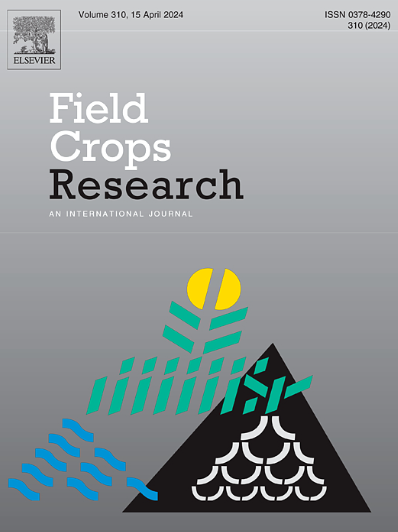Interplay between quantitative trait loci for stem strength and agronomic traits in a wheat doubled-haploid population
IF 5.6
1区 农林科学
Q1 AGRONOMY
引用次数: 0
Abstract
Context
Stem strength in wheat is important for mechanical stability, supporting nutrient translocation and lodging tolerance to uphold yield potential and grain quality.
Objective
The main objectives of this study were to identify quantitative trait loci (QTLs) for stem strength and diameter and determine if stem biomechanical QTLs overlap with QTLs for yield and other agronomic traits.
Methods
A doubled haploid wheat population between the distinct parents AC Cadillac and Carberry was assessed for stem biomechanical traits together with lodging, height, heading date, and yield parameters. Multi-environment QTL mapping was performed to identify potential QTL hotspots, facilitate ideotype analysis, and examine putative candidate genes.
Results
Phenotypic analyses across 6 field environments revealed significant variation for 16 stem and agronomic traits with only stem wall thickness, grain yield, and thousand-kernel-weight (TKW) not differing significantly between parents AC Cadillac and Carberry. The Reduced height (Rht) allele Rht-B1b, present in Carberry, was the main driver of trait differences within the population, not only reducing height but also traits such as stem bending moment and TKW. QTL mapping revealed loci for stem traits present on chromosomes 2B, 2D, 4B, 5A, 6A, 6B, 7A, and 7D. There were distinct overlaps of stem trait QTLs with those of other traits including a heading date QTL on 2B and as well as grain size QTLs on 2D, 6A, and 6B. QTLs on 2D, 6A, and 6B compensated for a decrease in TKW largely driven by Rht-B1b in Carberry and also promoted an overall increase in stem diameter and stem bending moment.
Conclusions
The study revealed the complexity of optimizing for stem strength-related ideotypes given the possible interactions with agronomic traits such as grain size which may have contrasting priorities for allele selections. The most promising QTL hotspot on chromosome 6A drove increases in TKW, stem wall thickness and stem bending moment.
Implication
The findings support broadening the scope of traits in stem biomechanical research studies to ensure pleiotropic effects, especially those on grain traits, are captured. The results obtained facilitate future work focused on the development of genetic markers for stem strength and overall germplasm improvement.
小麦双单倍体群体茎强数量性状位点与农艺性状的相互作用
小麦茎秆强度对机械稳定性、养分转运和抗倒伏能力至关重要,从而维持产量潜力和籽粒品质。目的鉴定茎秆强度和直径的数量性状位点(qtl),并确定茎秆生物力学性状的qtl是否与产量和其他农艺性状的qtl重叠。方法对不同亲本AC卡迪拉克和Carberry的双单倍体小麦群体进行茎秆生物力学性状及倒伏、高度、抽穗期和产量参数的评价。进行多环境QTL定位,以确定潜在的QTL热点,促进理想型分析,并检查假定的候选基因。结果6个大田环境的表型分析显示,AC卡迪拉克亲本和Carberry亲本在16个茎秆农艺性状上均存在显著差异,其中茎壁厚、籽粒产量和千粒重在亲本AC卡迪拉克和Carberry亲本间差异不显著。低高等位基因Rht- b1b是红莓群体内性状差异的主要驱动因子,不仅降低了高,还影响了茎秆弯矩和TKW等性状。QTL定位结果显示,茎性状位点存在于2B、2D、4B、5A、6A、6B、7A和7D染色体上。茎部性状的QTL与2B上的抽穗期QTL以及2D、6A和6B上的籽粒大小QTL存在明显的重叠。2D、6A和6B上的qtl弥补了红莓中主要由Rht-B1b引起的TKW下降,并促进了茎粗和茎弯矩的整体增加。结论该研究揭示了茎秆强度相关理想型优化的复杂性,考虑到籽粒大小等农艺性状之间可能存在的相互作用,这些性状可能在等位基因选择中具有不同的优先级。6A染色体上最有希望的QTL热点是TKW、茎壁厚度和茎弯矩的增加。研究结果支持在茎生物力学研究中扩大性状的范围,以确保捕获多效效应,特别是对籽粒性状的多效效应。研究结果为今后茎强遗传标记的开发和种质资源改良提供了基础。
本文章由计算机程序翻译,如有差异,请以英文原文为准。
求助全文
约1分钟内获得全文
求助全文
来源期刊

Field Crops Research
农林科学-农艺学
CiteScore
9.60
自引率
12.10%
发文量
307
审稿时长
46 days
期刊介绍:
Field Crops Research is an international journal publishing scientific articles on:
√ experimental and modelling research at field, farm and landscape levels
on temperate and tropical crops and cropping systems,
with a focus on crop ecology and physiology, agronomy, and plant genetics and breeding.
 求助内容:
求助内容: 应助结果提醒方式:
应助结果提醒方式:


